This is a Nikkormat FT3, a 35mm single lens reflex camera produced by Nippon Kogaku in Tokyo, Japan between the years 1977 and 1979. The FT3 was the last camera produced with the Nikkormat name. The Nikkormat FT3 is improved from the previous model by adding support for Nippon Kogaku’s new automatic index (Ai) feature which allows for easier lens mounting and more advanced metering systems soon to come. The FT3, like the FT2 that preceded it, also uses a 1.5v silver-oxide battery, instead of mercury batteries like earlier cameras did, making it a more appealing camera to shoot today. Cameras from the Nikkormat series are highly sought after today for the same reasons they were when they were new, they’re incredibly well built and reliable cameras that with regular servicing can last a lifetime.
Film Type: 135 (35mm)
Lens: 50mm f/1.8 Nikon Nikkor coated 6-elements in 4-groups
Lens Mount: Nikon F Bayonet
Focus: 1.5 feet Infinity, Variable by Lens
Viewfinder: Fixed SLR Pentaprism, 95% Field of View, 0.8x Magnification
Shutter: Copal Square S Vertically Traveling Focal Plane
Speeds: B, 1 – 1/1000 seconds
Exposure Meter: TTL Coupled CdS Cell w/ top plate and viewfinder match needle
Battery: 1.5v LR44/357 Silver Oxide Battery
Flash Mount: Hot shoe and M and X Flash Sync, 1/125 X-sync
Other Features: Self-Timer, DOF Preview, Mirror Lock Up
Weight: 970 grams, 756 grams (body only)
Manual: https://www.cameramanuals.org/nikon_pdf/nikkormat_ft3.pdf
How these ratings work |
The Nikkormat FT3 was the final, and most technologically advanced of Nippon Kogaku’s mid-level 35mm SLRs. Although meant to be a step down from the Nikon F and F2, the entire Nikkormat series proved itself to be just as reliable, rugged, and compatible with nearly all Nikon F-mount lenses, making it an almost equal on every level. As a fully mechanical SLR today, the Nikkormat FT3 offers the perfect balance of an old school big body metal SLR with just enough modern conveniences to make it a very capable camera today. All the Nikkormats were good cameras, but the FT3 is just a little bit better. | ||||||
| Images | Handling | Features | Viewfinder | Feel & Beauty | History | Age | |
| 2 | 2 | 1 | 2 | 2 | 1 | 0% | |
| Bonus | +1 for the complete package, the best Nikon that’s not a Nikon | ||||||
| Final Score | 11.0 | ||||||
History
When Leitz introduced the Leica M3 in late 1953, Nippon Kogaku saw it as the end of an era. While the company’s earlier Nikon rangefinders were seen as competent alternatives to screw mount Leica II and IIIs being sold at the same time, the M3 was a game changer. It took the entire photographic world by surprise as not only was the M3 an improvement from earlier models, it signaled a monumental shift in how 35mm rangefinder cameras should be.

Nippon Kogaku was hard at work on the Nikon S2, but after seeing what Leitz had done with the Leica M3, Masahiko Fuketa, the man in charge of the Nikon rangefinder’s design felt that the M3 would be the pinnacle of rangefinder design. Nippon Kogaku could certainly play catch up and eventually make something equal to, or even marginally better than the M3, but he knew that if his company was ever going to stand alone as a camera making powerhouse, they would have to come up with something new.
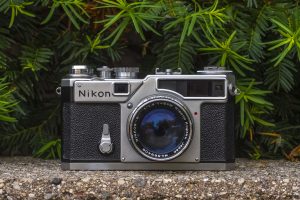
In 1955, when work began on the successor to the Nikon S2, Fuketa also started work on an all new single lens reflex camera. In order to maximize his design budget and limited factory space, the two cameras that would eventually become the Nikon SP and Nikon F were built off the same body and shutter. When it was released in 1959, the Nikon Reflex (it was not immediately called the Nikon F) shared a large number of parts from the Nikon SP.
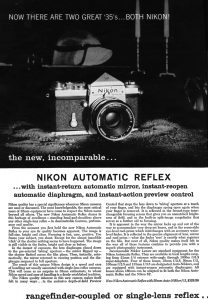
Although Nippon Kogaku was not the first company to make a 35mm SLR, the Nikon Reflex was unlike any other SLR that came before it. Built to incredibly high standards and with a long list of features demanded by professional photographers of the time, Nippon Kogaku’s new SLR singlehandedly changed the industry.
No longer a small Japanese company that made great lenses and pretty good cameras, Nippon Kogaku was an SLR powerhouse. Their new SLR quickly became so popular that the company could not make them fast enough. As a result, Nippon Kogaku had to repurpose valuable factory space used to make rangefinders for SLR production. Development of successors to the Nikon SP was halted and a large majority of the company became SLR focused.
Strong sales for the Nikon Reflex proved to be a blessing and a curse for Nippon Kogaku. A blessing in the sense that it had the world’s number 1 professional SLR, but also, Nippon Kogaku ONLY had the world’s number 1 professional SLR. Demand was so high for the Nikon Reflex, the company could not compete in any other segment. As a result, nearly every other camera maker, both in Japan and elsewhere, targeted down market customers, selling entry to mid level SLRs in masses to a population of photographers interested in the format, but not yet in the market for a professional kit.
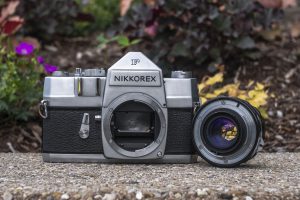
Not willing to devote any space towards manufacturing a second SLR model, in 1960, Nippon Kogaku partnered with Mamiya and released a line of Nikkorex SLRs built on the body of existing Mamiya SLRs. Most Nikkorex cameras had leaf shutter designs and fixed lenses, but one model, the Nikkorex F from 1962 used the company’s Nikon F interchangeable lens mount, and instead of a leaf shutter, had a Copal Square focal plane shutter. For the first time ever, Nippon Kogaku had two interchangeable lens SLRs. For someone looking to get into the Nikon F-system, they could purchase the much cheaper Nikkorex F, build up a collection of lenses, and later upgrade.
The Nikkorex F was a moderate success, staying in production for nearly four years. It was built by someone else, and despite using the same lenses, Nippon Kogaku found that very few people who bought one would later upgrade to the Nikon F.
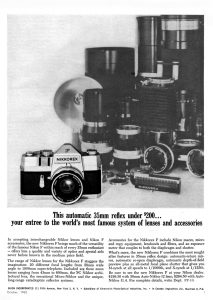
At the same time as, or shortly after the release of the Nikkorex F, Nippon Kogaku saw the need to release an all new SLR, designed from the ground up to be a worthy step down model to the Nikon F.
The exact history of who was in charge of Nippon Kogaku’s as yet unnamed camera is unclear, but it was pretty obvious that an effort to maintain a family resemblance was made. From the very beginning, the new camera was going to have a fixed pentaprism, a vertically traveling focal plane shutter, would support the Nikon F bayonet mount, and would have an in body exposure meter.
As the camera’s development progressed, things such as the shutter speed ring around the lens mount, the exposure counter, film advance lever and other controls took shape.
Two years into the new camera’s development, the camera was given the name Nikomat. A common rumor of why the new camera wasn’t called Nikon goes back to the original Nikkorex in which it was thought that Nippon Kogaku was terrified that somehow having two cameras with the name Nikon might somehow tarnish the reputation of the professional Nikon F. While it’s not entirely implausible to think that a company would want different names for their top end and mid range products, the presence of the consumer friendly auto exposure Nikon Auto 35 in 1964 somewhat disproves that rumor.
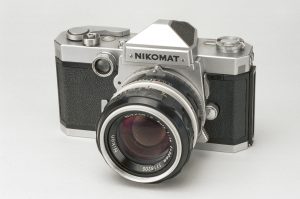
By mid 1964, the design and specifications of the new camera, now called the Nikomat, was almost set. One problem however is that as of 1962 when work began on the camera, SLRs with body mounted exposure meters were pretty common, but after the release of models with a Through the Lens (TTL) Meter like the Topcon RE Super in 1963 and Asahi Pentax Spotmatic in early 1964, it became clear that the Nikomat needed to be more competitive. Early prototypes of Nikomats with body mounted meters like the one shown to the right exist, but were never sold.
The Nikomat’s designers went back to the drawing board and made changes to the camera’s body, prism, and metering system to allow for a TTL CdS meter to be used in what would become the Nikomat FT. These final changes were expedited and completed in less than 5 months for the new camera’s release in July 1965. Very early Nikomat FT bodies have a blank circle in the body location where the original body mounted meter would have been, suggesting that some left over parts were used. At the same time as the Nikomat FT’s release, an unmetered model called the Nikomat FS was also released. Whether or not the unmetered FS was always planned, or whether it was the result of last minute shuffling of the meter is anyone’s guess.
Nikomat F: The presence of the letter “T” in the name Nikomat FT name suggests TTL metering, which if true, suggests that perhaps had the original version of the camera with a body mounted meter been released, it might have been called the Nikomat F, which makes sense since it would have been the little brother to the Nikon F.
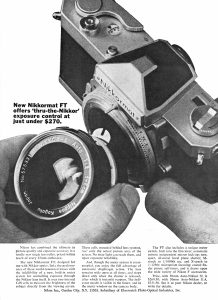
The Nikomat was a tremendous success, both in Japan and in western countries like the United States where it was sold as the Nikkormat. When it first went on sale, the Nikkormat FT came standard with a Nikkor 50mm f/2 lens for a price of $279.50, which when adjusted for inflation, compares to just under $2500 today. This was certainly a steep price, but still a bargain compared to a Nikon F with Photomic T prism and the same lens at $371.
The Nikkormat was a rousing success, both for photographers who wanted Nikon quality but not the Nikon price, but also for professional photographers who needed a capable backup body. In October 1967, the Nikkormat FTn would be released which made several improvements to the camera. The two biggest changes were a switch from a meter that took an average reading across the viewfinder to a 60/40 center-weighted reading which was useful in more situations. The second was made to the lens coupling pin and how the camera body detected not only the maximum aperture of whatever lens was attached, but also the selected f/stop. This simplified the installation of lenses and reduced chances for metering errors.
Other changes to the FTn were:
- New and brighter Type A or J focusing screens
- Different design of exposure counter window
- Different grain texture to body covering
- Stainless bushing added to strap lug to reduce wear
- Other internal differences
The Nikkormat FTn was in production for 8 years and would become the best selling of the entire Nikomat/Nikkormat line with over 1 million produced. In 1975, the FTn was replaced by an updated model called the FT2. Like when the FTn was released, the FT2 didn’t veer far from the original formula, offering a handful of evolutionary upgrades such as:
- Switch to 1.5v silver-oxide LR44 cell instead of 1.35v mercury cell
- Flash hot shoe on top of pentaprism
- Combined two PC flash terminals into one
- Black plastic tips on the self timer and film advance levers
- Taller shutter release and guard
- New and brighter Type K focusing screen with split image focus aide
- Revised ASA film speed lever with a lock to prevent accidental changes
- +/- indicators on the top plate meter readout
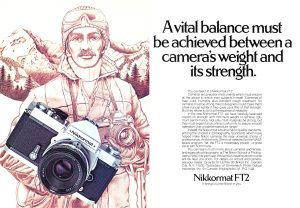
The FT2 was produced for two years and in 1977 was replaced by one final model, the FT3 which only had one change, but it was a big one.
Ever since the first metered prisms were made for the Nikon F, all metered interchangeable lens Nippon Kogaku SLRs used an external coupling between the lens and camera body to detect both the maximum aperture of the lens and the physical position of the aperture ring. This coupling consisted of a metal pin that needed to be slid between two “bunny ears” mounted to the aperture ring on the lens, As different f/stops were chosen, this pin would move, telling the camera how much light to expect through the lens.
With the Nikkormat FT3, Nippon Kogaku had created an automatic indexing, or Ai system in which this coupling is built directly into the lens flange. This not only eliminated the need for this coupling pin, but made mounting and dismounting lenses much easier.
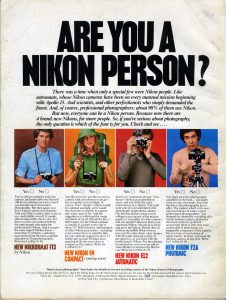
The new Ai system was simultaneously released on the FT3 along with two new metered prisms for the Nikon F2 called the DP-11 and DP-12. When included with an F2 body, the camera was marked as the F2A and F2AS respectively. A couple months after the release of the FT3 came the Nikon EL2, which was an updated version of the earlier electronic shutter Nikomat/Nikkormat EL. Despite being given the “Nikon” name, the EL2 was basically an electronic shutter version of the FT3 with aperture priority auto exposure.
When it was being produced, I couldn’t find any prices for the FT3, but in a 1975 test of the Nikkormat FT2, it’s manufacturer suggested retail price was listed as $503 with a Nikkor 50mm f/1.4 lens and $411.50 with an f/2 lens. Although I have no evidence of this, my best guess is that the FT3 probably sold for the same, or possibly even less than the FT2 as Nippon Kogaku already knew this was going to be a short lived model. Regardless of what the MSRP was, actual street prices that someone would pay for the camera were typically a lot less than this.
Both the FT2 and EL2 models were produced for a short period of time as the very same year, Nippon Kogaku would also release the Nikon FM and FE, two cameras with very similar features, but in a more compact and lighter weight body to better compete with the likes of the Olympus OM-series and Canon A-series.
Information online suggests the Nikkormat FT3 was produced only for a couple of months in 1977 but was available as new old stock until 1979. While this very well may be true, I’ve also seen production numbers of 128,000 units made, which is nearly identical to the original FT that was in production for 2 years. Unless Nippon Kogaku simply made a heck of a lot of these in a very short period of time, or whether the cameras were still in active production for more than a couple months is unclear, but whatever the case, the FT3 was the second lowest produced mechanical shutter Nikkormats, being behind only the FS.
Today, the entire Nikkormat series is still popular with collectors and film photographers for many of the same reasons the cameras were originally made, that they are built to a very high quality standard and are a cost effective way to get into Nikon F-Mount lenses. The later electronic era Nikon SLRs might have more modern conveniences, and are pretty reliable too, but having a fully mechanical SLR made almost entirely of metal has a feel and longevity that even the best electronic cameras can’t match.
Of the Nikkormats, the FT2 and FT3s are probably the best of the best for their use of easy to find 1.5v silver oxide and alkaline batteries and also the FT3’s use of Nikkor Ai lenses.
My Thoughts
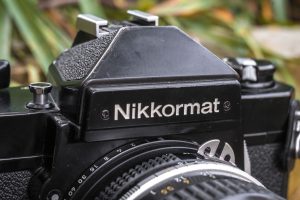
The Nikon EL2 was the very first film SLR I bought when I started collecting (I didn’t quite know it was collecting then) cameras in 2014. While the EL2 isn’t labeled “Nikkormat” it belongs to the same family of Nippon Kogaku’s advanced amateur line of fixed prism, F-mount SLRs which they produced from 1964 to 1978.
In the years since, I’ve come across many Nikkormats. At various times, I’ve probably had a dozen FT, FTN, and FT2 models. Many of them worked, and although I knew in my heart they were fantastic cameras, they never really excited me much, at least not enough to want to write a review about them. When selecting cameras to write about, I tend to pick those which either have something fascinating or innovative about them, or models that simply don’t have a lot of information already out there. The Nikkormats, for as good as they are, were pretty typical mechanical SLRs that other than being built to a very high quality standard, don’t offer much in the way of innovative or interesting features, and of course, there’s already tons of info out there about them.
Throughout the life of the Nikkormat line, Nippon Kogaku incrementally improved the camera, upgrading it’s features, first upgrading the lens coupling and making changes to the metering system, then switching the power supply to modern 1.5v silver oxide batteries instead of 1.35v mercuries, then in 1977, by adding support for Nippon Kogaku’s new automatic indexing lenses.
Nikkor Ai lenses differ from the older non-Ai lenses by no longer requiring the two prong “rabbit ears” that were common lenses of this era. Instead, a groove cut into the mounting flange allowed the camera to immediately detect the selected aperture of whatever lens was attached and calibrate the meter accordingly. This final model was the FT3, and with these modern upgrades to a classic camera, I figured if there ever was a Nikkormat I would review, this would be it.
Like all Nikkormats that came before it, the FT3 is large and heavy. With a period correct Ai Nikkor 50mm f/1.8 lens mounted, the camera weighs in at 970 grams. The same lens mounted to an original Nikon F with standard prism is 910 grams. Although the Nikkormat series was created as a less expensive alternative to the F-series, they certainly didn’t cut costs with cheaper materials as the camera’s heft is backed up by decades of evidence that these are very well built and durable cameras.

Up top the Nikkormat FT3 looks like most other Nikon SLRs. On the left is the rewind knob with fold out handle and next to it a top plate meter readout. Next to the meter readout is both the camera’s serial number and a reminder of which model it is. This is useful when identifying Nikkormats as most of them look very similar and it can sometimes be difficult if you’re looking at an FT, FTN, FT2, or FT3.
In the center is a fixed pentaprism with flash hot shoe above it. Unlike the Nikon F-series in which the shoes and viewfinders are removable, both are fixed here. Above and to the right of the pentaprism is a small depth of field preview button. Press and hold this button while looking through the viewfinder and the lens iris will stop down to whatever f/stop you’ve chosen, darkening the viewfinder.
Where the Nikkormat makes a big deviation from any other Nikon SLR, before and after it, is that the shutter speed dial is not on the top plate, but instead around the perimeter of the lens mount similar to the Olympus OM-series. In it’s place is an extra large and very easy to read automatic resetting exposure counter. To the left of that is the cable threaded shutter release and film advance lever. Like most Nikon SLRs, the film advance lever has an approximate 15 degree standoff, keeping it ready for the next exposure. A full wind of the lever must be made in a single motion as smaller incremental motions are not allowed.
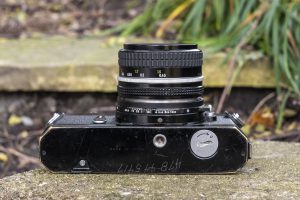
Flip the camera over and all you’ll see are the rewind release button, centrally located 1/4″ tripod socket, and the round opening for the battery chamber. No motor drive was made for this model. Starting with the Nikkormat FT2, the camera is powered by a single 1.5v LR44 Silver Oxide battery, which is ideal today as mercury batteries are no longer sold, and trying a modern substitute can throw off the meter. The battery cover uses a bayonet mount rather than screw threads, so removing it only requires a short 90 degree twist and it will come off.
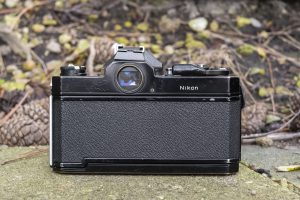
Around back, there is little to see other than the round eyepiece for the viewfinder and the name Nikon engraved in the back plate. The eye piece is internally threaded to accept all available eyepiece accessories made for the Nikon F and F2 offering a good upgrade path for someone who needed that sort of thing.
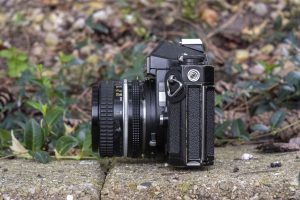
The Nikkormat FT3 would have been one of the last 35mm cameras made with the door release catch still on the side. By 1977 when this camera was released, most models had switched to using the rewind knob as the door release. Above the release catch is a flash sync port for externally connected flash guns. Also visible on this side of the mirror box is the mirror lock up switch which would be used for very long exposures to minimize body shake from the reflex mirror, or for special purpose lenses whose rear element would interfere with the mirror.
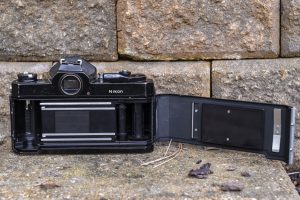
The right hinged door opens to reveal the Nikkormat’s film compartment. Film transports from left to right onto a multi-slotted and fixed take up spool. As with most Nippon Kogaku cameras, the take up spool rotates clockwise which rolls the film in the opposite direction of how it is in the cassette. This is said to help with film flatness as it passes over the film plane. The film door has a large metal pressure plate with divots and a metal roller on the side to also help reduce friction. The Nikkormat originally came with foam light seals which needed replacing on this model, as would be the case of any others you’d find for sale today.
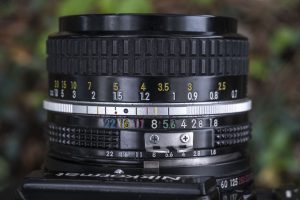
Perhaps the best feature of the entire Nikkormat series is full support for the entire family of Nikon F-mount lenses. Every Nikkor lens produced for the original Nikon F in 1959 all the way through the end of the manual focus era will work on this camera. As is the case with Nikkor lenses, the focus and aperture rings rotate opposite of most other major SLR makers. This usually isn’t much of a problem for most people, but on occasion, people will complain about it.
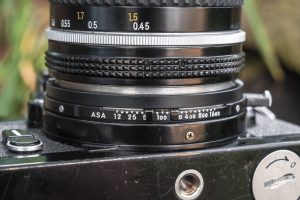
At the base of the lens mount is the ASA film speed scale. When using the Nikkormat FT3’s meter, this slider must be changed to whatever film is loaded into the camera. Supported speeds are from ASA 12 to 1600.
The ASA film speed selector locks in place via a chrome tab on the tip of the shutter speed selector. You must pull this chrome tab away from the lens mount to be able to change film speeds. If you are having trouble changing speeds, the most likely explanation is you forgot to release the lock.
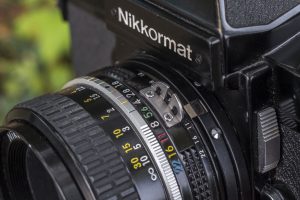
The Nikkormat FT3 supports automatic indexing (Ai) Nikkor lenses. These lenses no longer use the bunny ears prong required by earlier Nikkormats and original Nikon F and F2 cameras. A small metal tab near the 1 o’clock position around the lens mount aligns with a notch on Nikkor Ai lenses to transmit the selected f/stop to the camera’s metering system. This tab interferes with non-Ai lenses, so in order to attach a non-Ai lens to the Nikkormat FT3, you can swing the Ai tab out of the way, first by pressing a chrome release button just below the tab. In the image to the right, this release button is just to the right of the small number 16.
With the Ai tab folded out of the way, non-Ai lenses can be attached to the camera. With a non-Ai lens mounted to the camera, it can no longer detect the selected f/stop, so you must use the depth of field preview button to manually stop down the lens before taking a meter reading. Forgetting to do this will result in improperly exposed images.
Ai vs non-Ai Lenses: Many people new to the Nikon SLR system get confused between the terms Ai and non-Ai. The difference is in how the lenses transmit the selected f/stop to the camera for it’s metering system. Nippon Kogaku retained backwards compatibility for the older system on most Ai lenses which is why the “bunny ear” prong is still there like on the lens in the previous image. If you are confused whether or not a Nikkor lens is Ai or non-Ai, the easiest way to tell is if there is a second row of f/stop numbers, usually all in white, nearest the lens mount. A very small number of non-Ai lenses received conversions to Ai, which may or may not have these numbers, but all genuine Ai lenses have the second row of numbers.
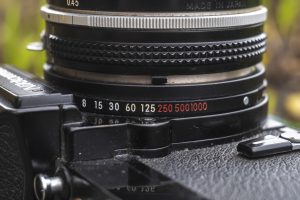
A big change that is unique to the Nikkormat series (except the EL) is the location of the shutter speed ring, which is around the lens mount. Changing shutter speeds is done by moving a lever which sticks out towards the side of the lens mount. Selected shutter speeds are indicated by a white dot near the 10 o’clock position around the lens mount but are also visible within the viewfinder. This was a similar system to how shutter speeds are changed on the Olympus OM-series. If looking at the side of the lens mount to see your chosen shutter speed does not seem ideal, the speeds are also visible from within the viewfinder.
The Nikkormat FT3 uses a type-K focusing screen which was not only the brightest available on the entire Nikkormat series, but it also includes a familiar split image and microprism focus aides, giving users the best possible chance of getting razor sharp images, even in less than ideal lighting.
Off to the right is the match needle display for the FT3’s meter showing + and – signs to indicate over and under exposure. In one of the most curious design decisions of the entire Nikkormat series, the + sign for overexposure is on the bottom, with the – sign on top. This seems counter intuitive as it would make more sense to have overexposure be above underexposure, but in reality, it’s not that difficult to get used to.
Finally, at the bottom of the viewable image is the shutter speed display, which shows the currently selected speed in the center, with adjacent speeds flanking it indicated in yellow. The presence of speeds to the left and right of the selected speed is helpful as it gives you a quick reminder of which direction to move the shutter speed ring for the next speed.
The Nikkormat series had been in production for over 10 years before the FT3 was released, so it’s control layout and ergonomics were likely already familiar to a lot of people. Despite not being Nippon Kogaku’s top of the line cameras, the Nikkormat series still compared favorably to the best of what other companies had to offer.
The Nikkormat FT3 has a long list of reasons to use it with only a very small minor of cons, but so far, all we’ve talked about is what it’s like to hold one, but what is it like to actually use one? Keep reading…
My Results
Having shot so many Nikon/Nikkormat cameras before, I had a pretty good idea of what to expect, so in the interest of trying something new, I loaded in a lightly expired roll of Fuji Neopan 1600. I generally stay away from fast films like this as I think smoother, lower grain films do a better job of showing what a lens could do. On the other hand, having a few extra stops of speed would allow me to hand hold the Nikkormat in lower light situations than I otherwise would be able to do.
Having shot a large number of Nikon SLRs with Nikkor lenses, I knew what to expect in terms of image quality. Sharpness would be excellent from corner to corner, contrast would be excellent, if I ever shot color film, that would be excellent too. There simply aren’t enough adjectives in the English language for me to keep coming up with new things to say every time I review a Nikon SLR.
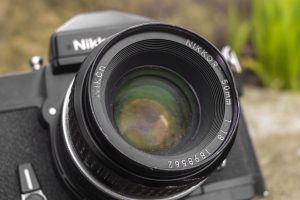
What I was interested in seeing was how the entirety of the Nikkormat FT3 worked together. By 1977 when this camera was released, the Nikkormat series was over a decade old and while Nippon Kogaku had made many meaningful updates to the line, was it enough? If I was a photographer in 1977 looking for a new camera, would I have been better off spending more money on an F2A or F2AS, or would I have been wise to wait a few months for either the FM or EL2?
Rather quickly while shooting the FT3, I was easily able to conclude that there are no wrong answers to the above questions. As was the case of every Nippon Kogaku SLR from this era, these were fantastic cameras. The choice between an FT3 and F2 depends on both budget and whether you need the additional features of a pro-level camera. The choice between an FT3 and FT2 depends on how many non-Ai lenses you already own, or are likely to buy. The choice between an FT3 and EL2 depends on whether you want an electronic or mechanical shutter and whether or not automatic exposure is important to you. Finally, the choice between the FT3 and FM depends on how much you value a more compact and lighter weight camera.
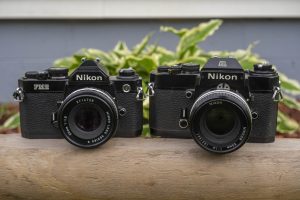
For me, the size and weight of the Nikkormat was not a problem. I found that with my average sized adult male hands, the camera fit nicely and allowed comfortable access to every one of the camera’s controls. I never found it to be too big or too heavy.
Compared to the Nikon EL2 which is my all time favorite Nikon SLR, I found the lack of auto exposure to be something I would rarely care about. As you can see in the gallery above, I had no problem getting properly exposed images in difficult lighting situations. Had I wanted to shoot slide film or something with absolute accuracy, I am sure the EL2 might have given me an edge, but for general purpose photography, the lack of the EL2’s more advanced electronics was not a hinderance.
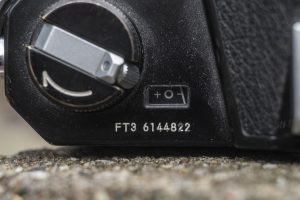
Finally, while I didn’t find the FT3 to be heavy, compared to my the Nikon F2, it still feels light and well balanced. With the compact 50mm f/1.8 lens mounted, the F2 isn’t too bad, but combine it with a heavier telephoto or super speed lens and your wrists will definitely get a workout.
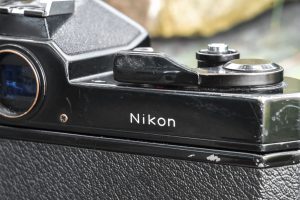
Is the Nikkormat FT3 the perfect Nikon SLR? I won’t go as far as to say that, but it is very, very good. Compared to the rest of the mechanical Nikkormats, it is definitely the one I would recommend. The use of a 1.5v silver oxide battery is a huge plus to both the FT2 and FT3 as not only are mercury batteries outlawed in my country, but there’s no worry the meter will be off due to using an incorrect voltage. The addition of support for Ai lenses, while still allowing backwards compatibility with non-Ai lenses means you have a huge selection of manual focus lenses to choose from. Finally, all of the other minor changes such as the Type K screen, plastic tipped controls, improved ASA speed selector, and flash hot shoe all add up to an immensely capable camera.
About the only negative I can say about the FT3 is that due to being produced in lower numbers than most other Nikkormats, it’s one of the hardest to find. About three times as many FT2s were made and eight times as many FTns, so you may have to do some digging to find a nice example, but if you do, I can absolutely guarantee you that you won’t be disappointed. I don’t think the Nikkormat FT3 will displace the EL2 as my favorite Nikon SLR, but it comes very close!
Related Posts You Might Enjoy
External Links
http://camera-wiki.org/wiki/Nikomat/Nikkormat_FT3
https://www.mir.com.my/rb/photography/hardwares/classics/nikkormat/fseries/ft3/index.htm
http://www.alexluyckx.com/blog/index.php/2016/09/23/ccr-review-46-nikon-nikkormat-ft3/
https://casualphotophile.com/2020/04/08/nikon-nikkormat-retrospective/
https://www.imagingpixel.com/p/nikkormat-ft3.html
https://vintagecameralab.com/nikon-nikkormat-ft3/
https://johnnymartyr.wordpress.com/2019/04/25/nikkormat-brutish-beautiful/

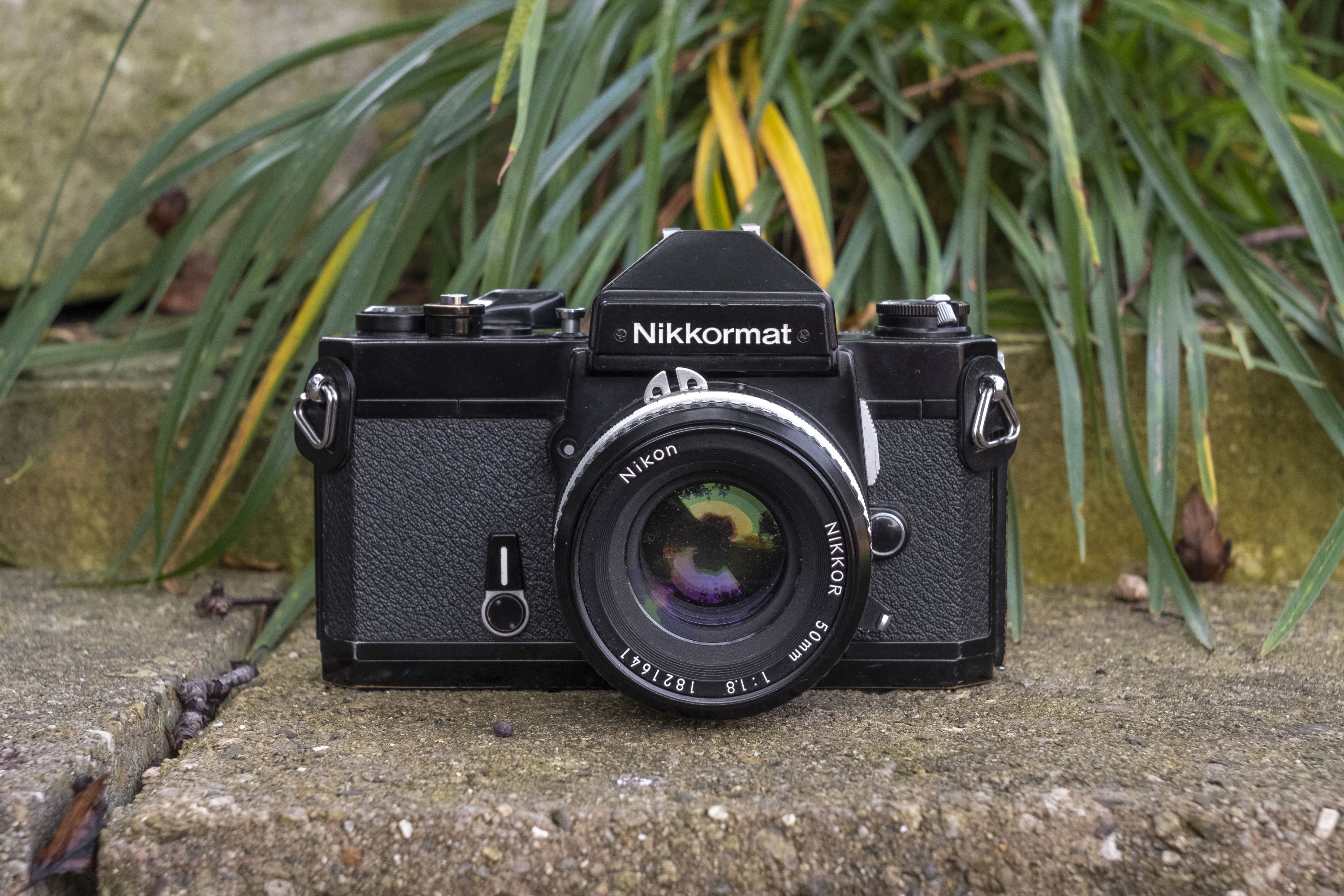
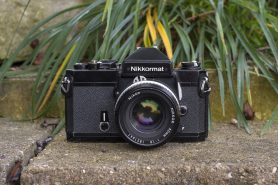
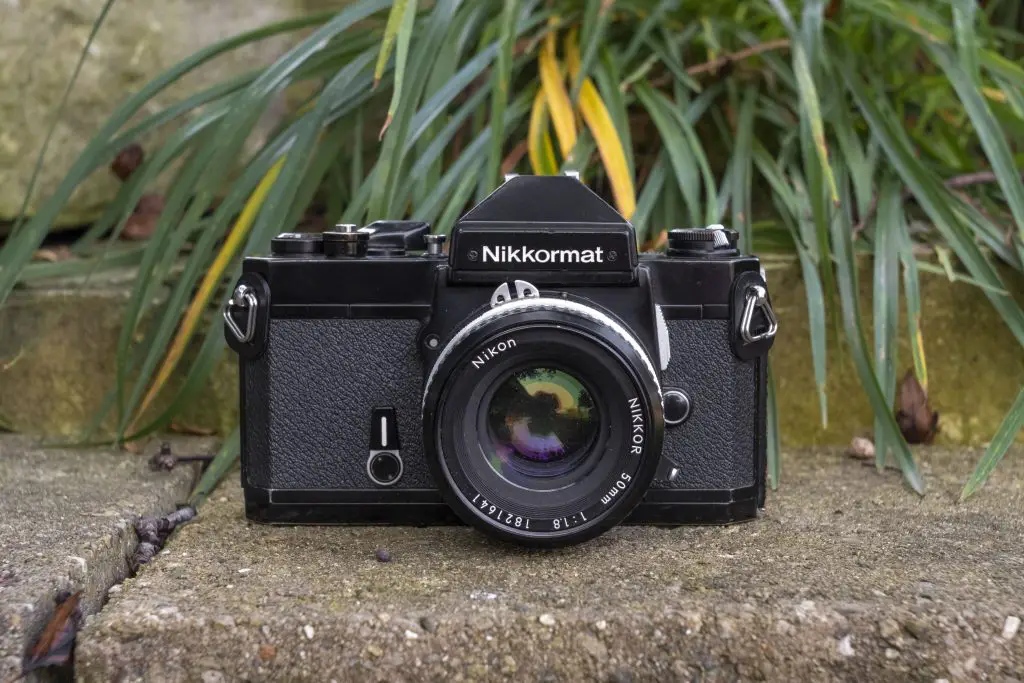
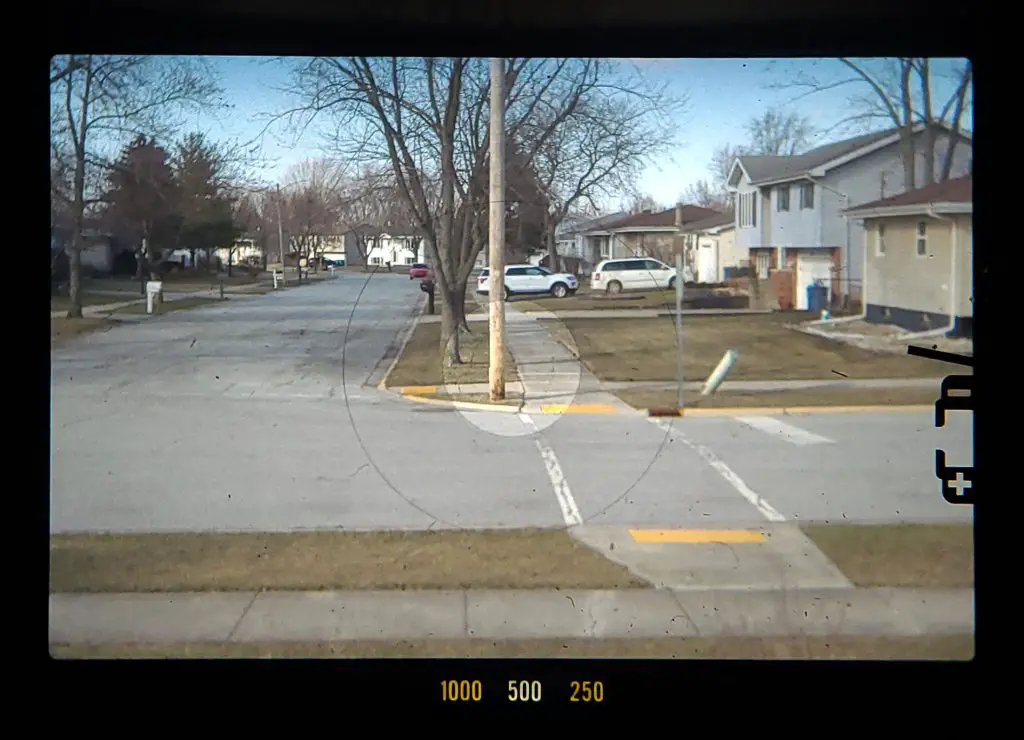
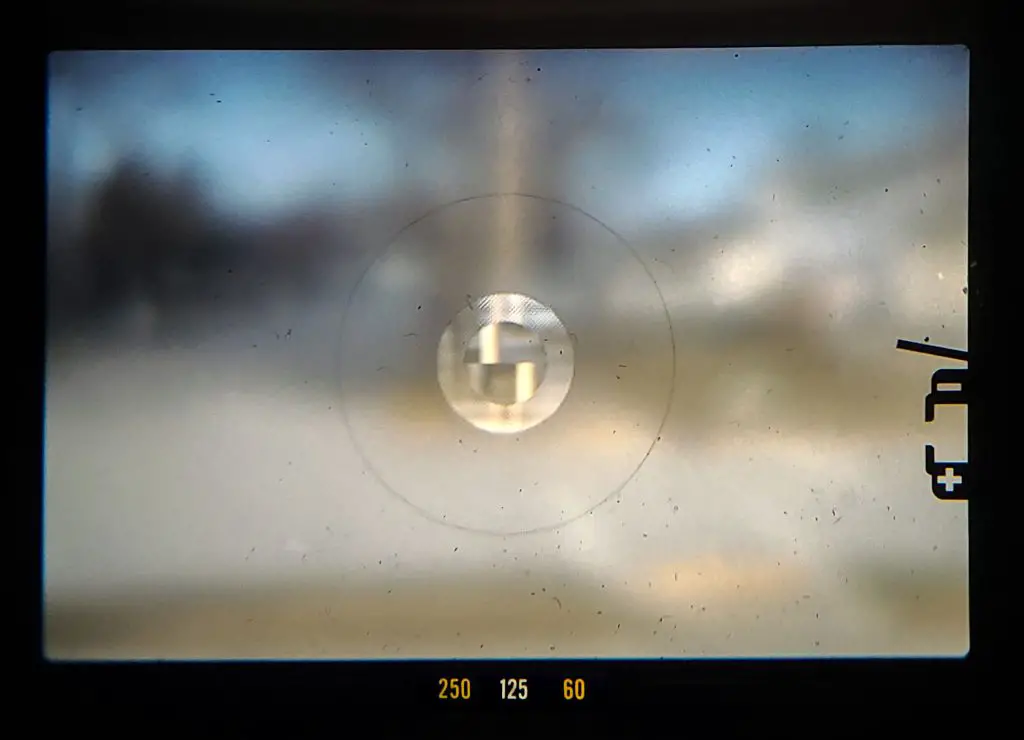
















FYI, according to Modern Photography Dec 1977, the price of the FT3 was $424.50 with 50mm f2, $519.50 with 50mm f1.4, $618 with 55mm f1.2. Black body was an additional $20.
Thank you very much! I have access to a ton of old Modern Photography’s but none from 1977! By any chance, do you have access to a scanner, and could scan that page in for me? If not, that’s OK, at least I got the right price!
Before digital, the K1000 was the standard recommended camera for students taking photography studies in school. Back then the camera had to be completely manual and was relatively cheap. Most likely that recommendation to current starting analog photographers is a hold back from those times.
Sure, no problem. How do I get the PDF to you since I see no provision for attachments?
Every time I see a K1000 with f1.8 lens sell for $200++ on eBay, while Nikkormats with f1.4 lenses sit unsold at $100, I wonder where our new analog photographers are getting their advice.
That is ridiculous isn’t it. A K1000 is almost as common as the Yashica Electro 35 and Argus Brick. I just acquired a 3rd FT2 in black. I already have one in black. However, apparently not many paid attention to the lens on the body as the type can’t seen head on when looking at the lens ring in the photo. I knew what that was. A Nikkor 85mm f1.8 which will work on my Sover CLA’d F2. Cost me $155 including shipping in a camera case. That is also ridiculous in a good way.
The closest I got to a Nikkormat FT3 was a few years ago at a PP of A-sponsored swap meet/sale. An acquaintance had a “gently used” one with a 50mm f/2 Nikkor for sale, but I was “in digital mode” with a Fujifilm X30. It did bring me back to the mid-1970’s when I bought a Nikkormat FTn body and equipped it with the budget-priced lenses a college student could afford.
A college classmate had bought a Canon FT, so there were comparisons about lens mounting, light metering, etc. The Nikkormat stayed in active use well into the 1980’s, sharing space with a Nikon F2 Photomic and several fixed-focal length Nikkors.
I worked around the Nikkormat’s operational foibles and wasn’t that bothered by them. Then the Nikon FM appeared and I set the Nikkormat aside. There weren’t any problems with the “old pronged vs. new AI coupling,” since I’d had all my Nikkors redone at the $18.50 per lens when it was offered. (“Am I going to buy the same focal length AI Nikkor lenses again? Nope, I’m not a millionaire!” was my thought at the time.;)
Looking back, if not for the “operates just like the Nikon F2” Nikon FM and FM2, I might have upgraded to the Nikkormat FT2 or FT3, since Mercury button cells are a thing of the past. (Yes, I didn’t buy a Nikon F because of the removable back.)
Thanks for your thoughts on the FT3, Mike, much appreciated
I already have a (Soverised) F2, but just came into possession of a very good condition black FT3 which was given to me by my sister-in-law. It was her father’s camera and included a 50mm f/2 lens. Sadly her father has dementia, so they’ve been clearing the house.
Anyway, the slight downer is that he didn’t heat his house properly and the lens has been wrecked by fungus. I’ve spotted the odd spore in the camera’s mirror box too, but I think with some cleaning and drying it’ll be fine. I’m just contemplating sending it off for a full CLA and new foams to Black On White in Bristol (UK). The overhaul will cost circa £120.00 and since the camera seems to be in such good condition, I think it’s worth it. Also then I have a backup to my F2 🙂
Sorry to hear about your sister-in-laws father. Dementia has got to be one of the hardest things to see a parent go through. As for the FT3, while the 120 pounds for a full CLA might seem like a questionable expense now, I would feel very confident that in doing so, you’ve extended the usable life of that camera by decades. These Nikkormats are already some of the most rugged and dependable cameras ever made, but to get one professionally cleaned and adjusted with new foam is the icing on the cake. When all these cheap LOMO cameras and electronic Yashica T4s are all dead in 20-30 years, that FT3 will still be shooting film (if there’s anyone left still making it!)
Hey Mike! Well I went ahead with the full CLA at my favourite camera repair shop in Bristol (UK), Black On White. They’ve done a fantastic job! The shutter speed ring in particular had been a bit stiff before, but now it turns smoothly and evenly from one click to the next. All the foams replaced, shutter speeds adjusted, the list goes on – they basically did a full tear-down and rebuild. Yet they held to the original quote so totally worth having the work done. I’m looking forward to getting out and giving it a good run soon 🙂
Glad to hear you spent the money to get that camera up and running in tip top shape! I am certain you just prolonged it’s life by another couple of decades worth of shooting goodness! 🙂